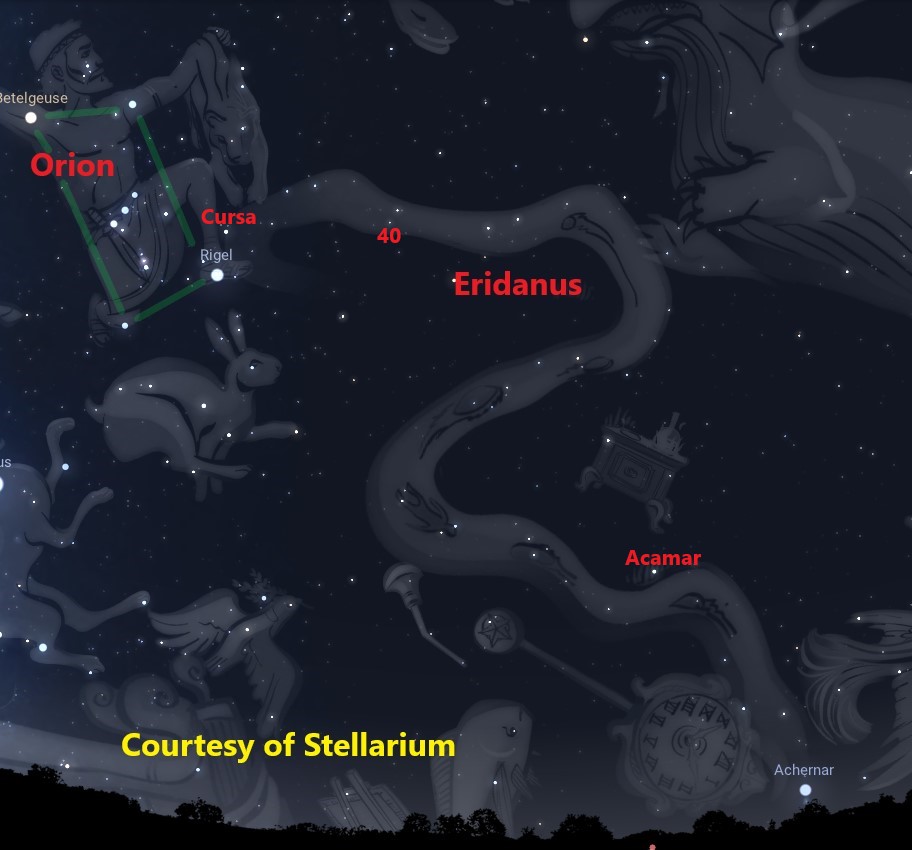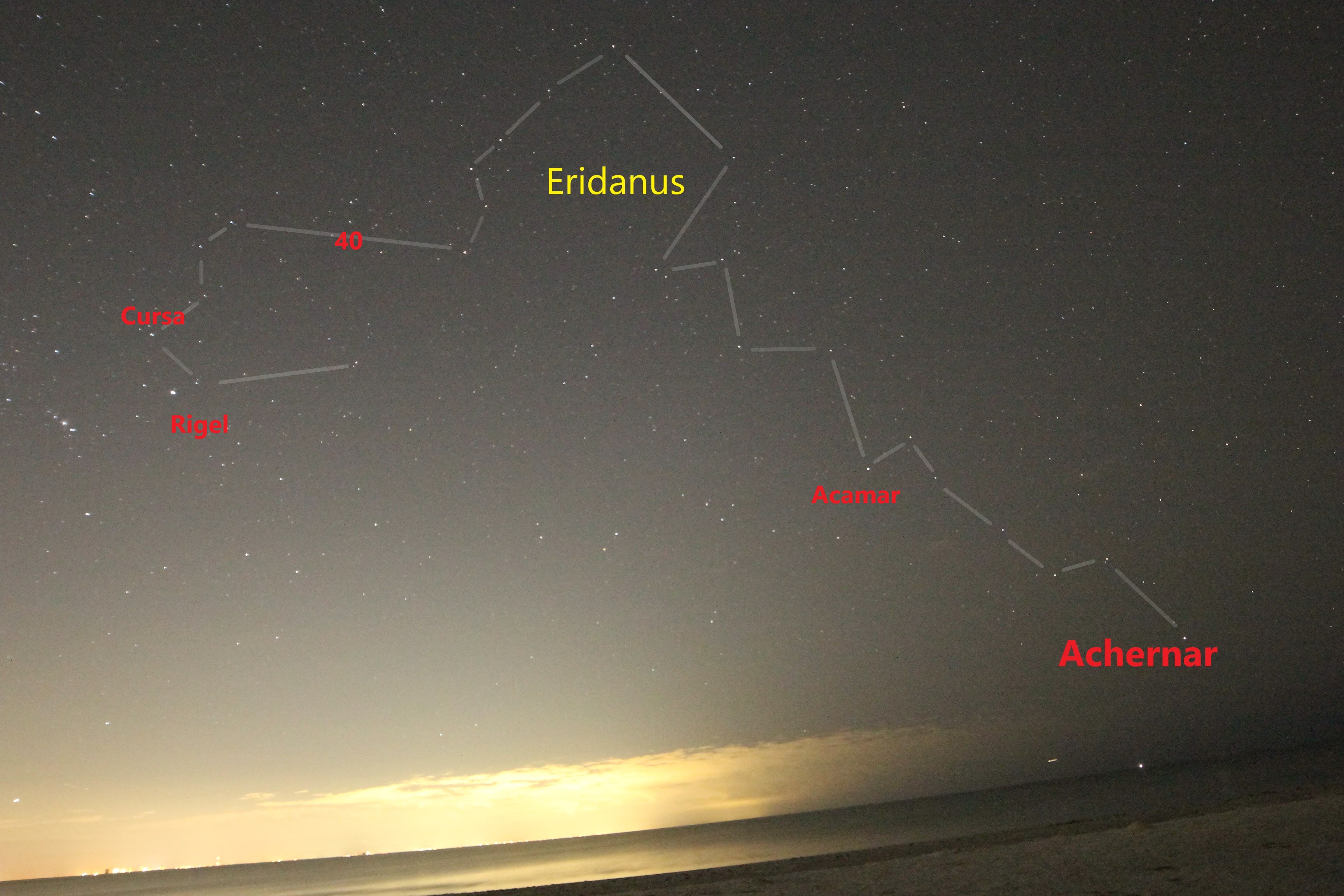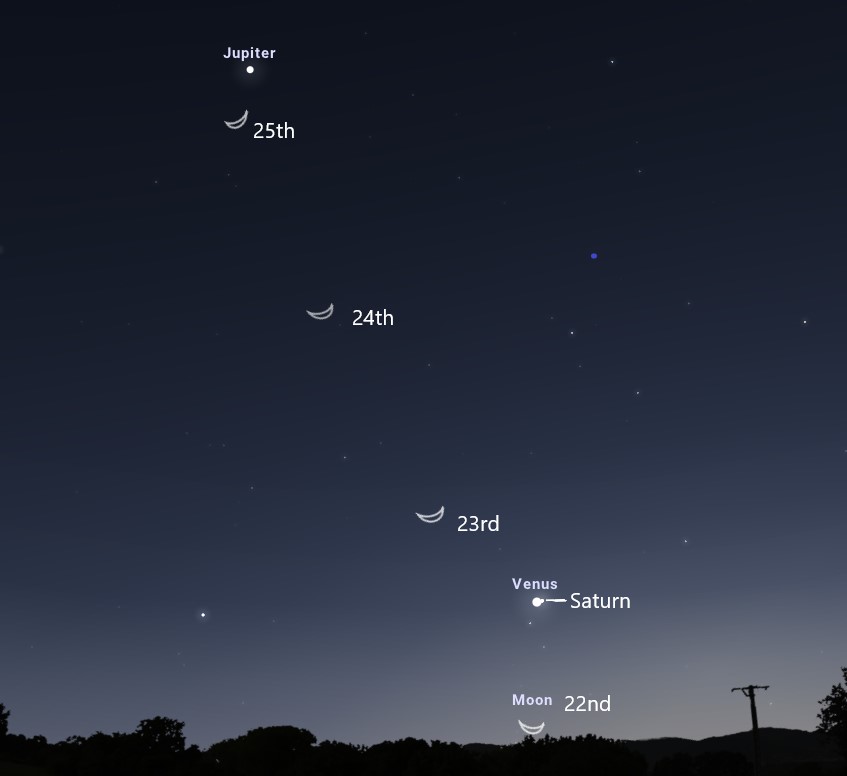RIDE THE LAZY RIVER IN THE SKY

Facing east to southeast, January early evenings. Note the familiar bright stars of Orion, the Hunter, with three stars in a row forming the belt. The star Cursa is the best way to start your ride on the river Eridanus, seen just above bright Rigel. As mentioned in the text, stars lower than Acamar on the map are not visible from St. Louis. Courtesy of Stellarium.
Many people, including my family, enjoy going to water parks. There usually is a spot where those brave or foolish enough can stand under the giant bucket as tons of water get dropped on you. You can go down tube and swirly slides and other attractions. I do enjoy these, but as I am getting older and slowing down a bit, I also like to take a break on the lazy or endless river which most of these parks seem to have. The sky also has its own lazy river, the constellation Eridanus.
Eridanus is associated with the famous Greek myth that included Phaethon, who persuaded his dad Helios, the Sun God, to allow him to pilot the sun chariot for the day, with predictably disastrous result. Phaethon ended up the victim of one of Zeus’ thunderbolts, and fell into the river. I went into more detail about this myth in my blog for this past August, which you can revisit here. It is not known which actual river Eridanus represents- some say it is the Po, others the Rhine or the Rhone.
Fittingly, the constellation Eridanus meanders rather aimlessly through the southeastern and southern sky during the evenings at this time of year. It contains no particularly bright stars that are visible from mid-northern latitudes, but I find that if you can go out to a dark country location, it actually isn’t too hard to trace out the pattern of Eridanus, as it sits in a rather empty region of the sky. If you live closer to the city, you can simulate country skies by taking out a pair of binoculars and hopping from star to star, using the picture below as a guide- but it is certainly easier the darker your location.

The constellation Eridanus. Photo taken by our Sky Ranger from Sanibel, Florida, December 2021. The stars below Acamar are too far south to be seen from the latitude of St. Louis. The lights of Fort Myers illuminate the horizon and clouds.
The best way to begin this swim on the lazy river is to start with the very bright constellation Orion, currently in the eastern sky. The brighter stars of Orion form a somewhat irregular rectangle, surrounding the famous three stars forming the belt. You can learn more about Orion in the January 2020 edition of this blog, available here. The star at the southwestern corner of the rectangle, bright Rigel, is the jumping-off point. As can be seen in the picture, Cursa, also known as Beta Eridani, second brightest in the constellation, appears above Rigel during early January evenings. Cursa’s light takes about 89 years to get to your eyes, and it is a giant star, about 25 times more luminous than our Sun. In Arabic, Cursa’s name means “footstool of the central one”, no doubt referring to Orion.
Starting from Cursa, you can head downward and then to the right to pick up the source of the river, or west and south to begin meandering. The star marked “40” on the map is a rather dim fourth magnitude as seen with the unaided eye (probably needs binoculars from close to the city), but is shown to actually be a triple system in a good telescope. Although most stars visible to the unaided eye are larger and intrinsically brighter than our Sun, it has been discovered that the 40 Eridani system is a relatively close 16 light years from Earth. 40 Eridani A, by far the brightest of the three, shines with an orange hue and thus is slightly less cooler and less luminous than our Sun. Some astronomers say that it could just possibly support life. Gene Roddenberry, creator of Star Trek, suggested that 40 Eridani A could be the host star of the planet Vulcan.
The B & C components of the system orbit some 37 billion miles from A, and are themselves about 3 billion miles apart, or similar to Neptune or Pluto’s distance from our Sun. They can be seen in a good telescope, and are noteworthy because Star B is an example of a white dwarf- a look ahead at the fate of our Sun in the very distant future- hot, tiny and very densely packed with matter. Star C is a typical red dwarf, the most common type in the Universe, but only seen when quite nearby, since they are small and comparatively dim and cool. A good telescope at a fairly high power is needed to resolve the B-C pair- I have done this one time. If there are any inhabitants of an actual planet “Vulcan” they would have a brilliant, orange “sun” (Star A) in the sky. They could also behold two extremely bright point sources of light that outshine our view of Jupiter perhaps a hundred-fold- one white and one red. May they live long and prosper!
As you continue to follow the lazy river through all of its twists and turns, you eventually come to the star Acamar, very low in the southern sky at the latitude of St. Louis. Its name means “end of the river” when translated into Arabic. This is ironic because once the southern skies were catalogued by astronomers beginning in the seventeenth century, more stars were added to the constellation. Nowadays, the lazy river Eridanus meets its terminus at the very bright star Achernar, whose name also means “end of the river.” Earth’s axis is tipped too far in the wrong direction for it to be seen at mid-northern latitudes, but I have seen it several times on my trips to Florida, including last December, when I took the picture shown above. Achernar doesn’t really fit in with the dimness of the rest of Eridanus- it ranks ninth in brightness of all the stars in the night sky. It is a very hot star, twice the size and 17 times more luminous than our Sun, and its light takes about 139 years to get to our eyes.
Now that we have completed our ride on the “lazy river” Eridanus, I wanted to quickly give some tips on how to continue to follow the planet bonanza that is still visible in the skies of January. Jupiter is the very bright “star” well up in the southwest early in the evening, while Venus shines brightly close to the southwestern horizon as the sky darkens after sunset. Saturn, much dimmer, is almost halfway between them as January opens but quickly appears to drop towards Venus as the days pass. As you can see in the image below, on the night of January 22nd, Saturn will be less than one Moon-width from Venus, and after that will continue to drop to Venus’ lower right. By the end of January, the ringed planet will be hard to see. Mars, steadily fading from its peak of early December, will still shine as the bright orange-tinted object high in the eastern sky.

Facing southwest, about 6 pm, January 22-25. Saturn is shown for the 22nd and will move to the lower right day by day. The moon will be very thin on the 22nd- binoculars help. Courtesy of Stellarium.
